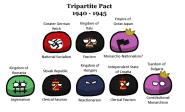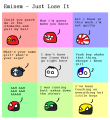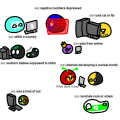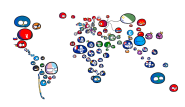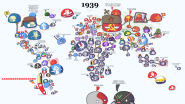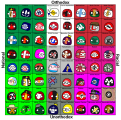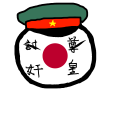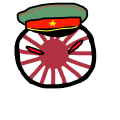TomokoKuroki (talk | contribs) No edit summary |
TomokoKuroki (talk | contribs) No edit summary |
||
| Line 7: | Line 7: | ||
Showaism<br> | Showaism<br> | ||
Showa Nationalism<br> | Showa Nationalism<br> | ||
Tōseiha/Kōdōha<br> | |||
[[File:JapImp.png]] Japanese Imperialism<br> | [[File:JapImp.png]] Japanese Imperialism<br> | ||
[[File:Tojo-alt.png]] Rapism (By [[File:Cball-Taiwan.png]] [[File:Cball-China.png]] Chinese and [[File:Cball-South_Korea.png]] [[File:Cball-North_Korea.png]] Korean people)<br> | [[File:Tojo-alt.png]] Rapism (By [[File:Cball-Taiwan.png]] [[File:Cball-China.png]] Chinese and [[File:Cball-South_Korea.png]] [[File:Cball-North_Korea.png]] Korean people)<br> | ||
Revision as of 23:24, 30 May 2024
Showa Statism (also called Showa Nationalism), shortened Showaism, was a totalitarian, ![]() ethno-ultranationalist, culturally far-right, economically 3rd positionist (specifically favoring corporatism) and expansionist ideology, which was practiced and developed in
ethno-ultranationalist, culturally far-right, economically 3rd positionist (specifically favoring corporatism) and expansionist ideology, which was practiced and developed in ![]() Japan during the first half of the reign of
Japan during the first half of the reign of ![]() Emperor Showa (at the time called Hirohito). Showa Statism was a political syncretism of extreme ideologies in Japan, which developed over time after the
Emperor Showa (at the time called Hirohito). Showa Statism was a political syncretism of extreme ideologies in Japan, which developed over time after the ![]() Meiji Restoration, when Japan overthrew the previous
Meiji Restoration, when Japan overthrew the previous ![]() Tokugawa Shogunate.
Tokugawa Shogunate.
History
Origins
Showa Statism's origins can be traced back to the Meiji Restoration. After the victory over China in the First Sino-Japanese War and over Russia in the Russo-Japanese War, Japan joined the Western powers. They needed a ![]() strong military to secure Japan's new overseas empire which was reinforced by a feeling that only through a strong military would Japan earn the respect of Western nations. The period where it was the most prominent was during the dawn of the
strong military to secure Japan's new overseas empire which was reinforced by a feeling that only through a strong military would Japan earn the respect of Western nations. The period where it was the most prominent was during the dawn of the ![]() Showa Period and throughout the Second World War. The first 20 years of Emperor Showa's reign it was characterized by extreme nationalism and a series of expansionist wars. It was a mixture of ideas such as
Showa Period and throughout the Second World War. The first 20 years of Emperor Showa's reign it was characterized by extreme nationalism and a series of expansionist wars. It was a mixture of ideas such as ![]() Japanese nationalism,
Japanese nationalism, ![]() militarism,
militarism, ![]() fascism (while disputed by some), and
fascism (while disputed by some), and ![]() corporatism, that was initiated by several political philosophers and thinkers in Japan. Those philosophers include
corporatism, that was initiated by several political philosophers and thinkers in Japan. Those philosophers include ![]() Ikka Kita,
Ikka Kita, ![]() Shumei Okawa, and
Shumei Okawa, and ![]() Sadao Araki. Many had different (sometimes outright contrasting) views, which is why Showa Statism could be described as ideologically syncretic.
Sadao Araki. Many had different (sometimes outright contrasting) views, which is why Showa Statism could be described as ideologically syncretic.
 The Rise of Militarism
The Rise of Militarism
 Kōdōha Faction
Kōdōha Faction
The Kōdōha or the Imperial Way Faction was founded by were ![]() General Sadao Araki and his protégé, Jinzaburō Masaki. The Kōdōha was a radical faction, that sought to establish a military government that promoted totalitarian, militaristic, and aggressive expansionist ideas and was mostly supported by young officers. The Kōdōha was strongly supportive of the hokushin-ron ("Northern Expansion Doctrine") strategy of a preemptive strike against the Soviet Union, believing that Siberia was in Japan's sphere of interest; although there were supporters of the Northern Expansion in the Tōseiha, the faction largely favored a more cautious defense expansion. Both factions had struggled to gain influence over the military after the Manchurian Incident, however, the Kodoha remained dominant until the resignation of Sadao Araki due to illness, and the Kodoha would start to decline in its influence over the military. Araki was replaced by General Senjūrō Hayashi, who had Tōseiha sympathies. Thus, after the February 26 Incident, the Kōdōha effectively ceased to exist, and the Tōseiha lost most of its raison d'être.
General Sadao Araki and his protégé, Jinzaburō Masaki. The Kōdōha was a radical faction, that sought to establish a military government that promoted totalitarian, militaristic, and aggressive expansionist ideas and was mostly supported by young officers. The Kōdōha was strongly supportive of the hokushin-ron ("Northern Expansion Doctrine") strategy of a preemptive strike against the Soviet Union, believing that Siberia was in Japan's sphere of interest; although there were supporters of the Northern Expansion in the Tōseiha, the faction largely favored a more cautious defense expansion. Both factions had struggled to gain influence over the military after the Manchurian Incident, however, the Kodoha remained dominant until the resignation of Sadao Araki due to illness, and the Kodoha would start to decline in its influence over the military. Araki was replaced by General Senjūrō Hayashi, who had Tōseiha sympathies. Thus, after the February 26 Incident, the Kōdōha effectively ceased to exist, and the Tōseiha lost most of its raison d'être.
 The Righteous Army
The Righteous Army
A group of ![]() young IJA officers who supported the radical Kodoha. The young officers believed that the problems facing the nation were the result of Japan drifting from the kokutai (国体) (an amorphous term often translated as "national polity", it roughly signifies the relationship between the Emperor and the state). To them, the "privileged classes," exploited the people,(Almost all of the young officers' subordinates were from poor peasant families or working-class) leading to widespread poverty in rural areas, and deceiving the Emperor, taking his power and weakening Japan. The solution, they believed, was a
young IJA officers who supported the radical Kodoha. The young officers believed that the problems facing the nation were the result of Japan drifting from the kokutai (国体) (an amorphous term often translated as "national polity", it roughly signifies the relationship between the Emperor and the state). To them, the "privileged classes," exploited the people,(Almost all of the young officers' subordinates were from poor peasant families or working-class) leading to widespread poverty in rural areas, and deceiving the Emperor, taking his power and weakening Japan. The solution, they believed, was a ![]() "Shōwa Restoration" modeled on the
"Shōwa Restoration" modeled on the ![]() Meiji Restoration of 70 years earlier. These beliefs were strongly influenced by contemporary nationalist thought, especially the political philosophy of
Meiji Restoration of 70 years earlier. These beliefs were strongly influenced by contemporary nationalist thought, especially the political philosophy of ![]() Ikki Kita On February 26th, 1936, they would attempt a military coup with the goal of purging the government and military leadership of their factional rivals and ideological opponents.
Ikki Kita On February 26th, 1936, they would attempt a military coup with the goal of purging the government and military leadership of their factional rivals and ideological opponents.
 Feburary 26th Incident (26-28 Feburary 1936)
Feburary 26th Incident (26-28 Feburary 1936)
The February 26th Incident (二・二六事件) was an attempted coup d'état in the Empire of Japan. It was organized by young officers known as the  Toseiha Faction
Toseiha Faction 
The Toseiha or the Control Faction was a political faction in the Imperial Japanese Army active in the 1920s and 1930s. The Tōseiha was created by Tetsuzan Nagata and  Totalitarian Period (1940-1945)
Totalitarian Period (1940-1945)
WIP
 Greater East Asia Co-Prosperity Sphere
Greater East Asia Co-Prosperity Sphere 
The Greater East Asia Co-Prosperity Sphere is a concept used to justify the ![]() Empire of Japan's
Empire of Japan's ![]() imperialism. It promoted the cultural and economic unity of East Asians, Southeast Asians, South Asians, and Oceanians. It saw for its
imperialism. It promoted the cultural and economic unity of East Asians, Southeast Asians, South Asians, and Oceanians. It saw for its ![]() Pan-Asian ideals of freedom and independence from the control of western powers. In practice, it was often used by
Pan-Asian ideals of freedom and independence from the control of western powers. In practice, it was often used by ![]() militarists and
militarists and ![]() nationalists, who saw an effective way to strengthen
nationalists, who saw an effective way to strengthen ![]() Japan and advance its superiority within Asia.
Japan and advance its superiority within Asia.
 Korea
Korea 
From 1910 to 1945, Korea was ruled as a part of the Empire of Japan. Upon its annexation, Japan declared that Korea would be officially named Chōsen. Taiwan
Taiwan
The island of  Manchukuo
Manchukuo
 Philippines
Philippines
WIP India
India 
The Provisional Government of Free India or, Azad Hind, was an Indian provisional government established in Japanese-occupied Singapore during World War II. Azad Hind was recognized as a legitimate state by only a small number of countries limited solely to Axis powers and their allies. This government participated as an observer in the Greater East Asia Conference in November 1943. Burma
Burma
The State of Burma was a Japanese puppet state created by Japan in 1942 during the Japanese occupation of Burma in World War II. As the war situation gradually turned against the Japanese, the Japanese government decided that Burma and the Philippines would become fully independent as part of the Greater East Asia Co-Prosperity Sphere, contrary to the original plan that independence only be granted after the completion of the war. Thailand
Thailand
WIP Vietnam
Vietnam
The Empire of Vietnam is a Japanese puppet state. Japan would invade Vietnam, which was originally a colony of  Malaysia and
Malaysia and  Singapore
Singapore
British Malaya, which compromised the Straits Settlements,  Indonesia
Indonesia
 Second Sino-Japanese War
Second Sino-Japanese War 
The Second Sino-Japanese War is an ![]() anti-fascist and
anti-fascist and ![]() anti-colonialist nationalist struggle of
anti-colonialist nationalist struggle of ![]() the Republic of China against the the
the Republic of China against the the ![]() Empire of Japan. The war made up the Chinese theater of the wider
Empire of Japan. The war made up the Chinese theater of the wider ![]() Pacific Theater of the Second World War. The start of the war is historically dated to the Marco Polo Bridge Incident on 7 July 1937, when a dispute between
Pacific Theater of the Second World War. The start of the war is historically dated to the Marco Polo Bridge Incident on 7 July 1937, when a dispute between ![]() Japanese and
Japanese and ![]() Chinese troops in Peking escalated into a full-scale invasion. This war is often regarded as the start of the Second World War in Asia. Following the Marco-Polo Bridge Incident, the
Chinese troops in Peking escalated into a full-scale invasion. This war is often regarded as the start of the Second World War in Asia. Following the Marco-Polo Bridge Incident, the ![]() Japanese were able to score major victories such as capturing large cities such as Beijing, Shanghai, and the
Japanese were able to score major victories such as capturing large cities such as Beijing, Shanghai, and the ![]() Chinese capital of Nanjing in 1937, which would result in the Rape of Nanjing/Nanjing Massacre. Prior to failing to stop the
Chinese capital of Nanjing in 1937, which would result in the Rape of Nanjing/Nanjing Massacre. Prior to failing to stop the ![]() Japanese forces in the Battle of Wuhan, the
Japanese forces in the Battle of Wuhan, the ![]() Chinese government was relocated to Chongqing. While Japan ruled the large cities, it lacked the adequate manpower to control
Chinese government was relocated to Chongqing. While Japan ruled the large cities, it lacked the adequate manpower to control ![]() China's vast countryside.
China's vast countryside.
The ![]() National Revolutionary Army under the command of Generalissimo
National Revolutionary Army under the command of Generalissimo ![]() Chiang Kai-shek bravely fought against Japanese fascist invaders in 22 major battles that were extremely bloody. By 1939, after Chinese victories in Changsha and Guangxi, the war reached a stalemate. The war would end on September 2nd, 1945, resulting in the
Chiang Kai-shek bravely fought against Japanese fascist invaders in 22 major battles that were extremely bloody. By 1939, after Chinese victories in Changsha and Guangxi, the war reached a stalemate. The war would end on September 2nd, 1945, resulting in the ![]() Japanese surrendering to the Allies. The Japanese troops committed countless war crimes and murdered at least 10 million civilians during this war, and were notorious for their war crimes, such as
Japanese surrendering to the Allies. The Japanese troops committed countless war crimes and murdered at least 10 million civilians during this war, and were notorious for their war crimes, such as ![]() 731 human experiments.
731 human experiments.
After the war, the Chinese economy collapsed due to the lack of ![]() American foreign aid in the war, unlike most other counties like
American foreign aid in the war, unlike most other counties like ![]() Britain,
Britain, ![]() Free France, and
Free France, and ![]() the USSR. The inflation rate skyrocketed, and corruption became extremely rampant. The
the USSR. The inflation rate skyrocketed, and corruption became extremely rampant. The ![]() CPC was able to take advantage of this and launched a major “offensive” after Japan surrendered and controlled 2/3 of the territories occupied by Japan after Japan surrendered. Many historians assess that this war destroyed the popularity and stability
CPC was able to take advantage of this and launched a major “offensive” after Japan surrendered and controlled 2/3 of the territories occupied by Japan after Japan surrendered. Many historians assess that this war destroyed the popularity and stability ![]() Nationalist Government and paved the way for the communist takeover as the communists made minimum efforts to resist Japan, but instead focused on expanding its troops to turn on the nationalists.
Nationalist Government and paved the way for the communist takeover as the communists made minimum efforts to resist Japan, but instead focused on expanding its troops to turn on the nationalists.
Beliefs
Due to the fact that Showa Japan was militarily allied with ![]() Nazi Germany and
Nazi Germany and ![]() Fascist Italy and shared ideological similarities, Showa Statism is usually taken to be a type of
Fascist Italy and shared ideological similarities, Showa Statism is usually taken to be a type of ![]() Fascism, although this is disputed by some. Showa Statism is a syncretism of extremist ideologies. Some believed to unify the Asian race under the sacred rule of the emperor, some believed it was their destiny to liberate Asia from Western powers. Showa Statism is anti-western, anti-liberal, anti-communist, and anti-capitalist.
Fascism, although this is disputed by some. Showa Statism is a syncretism of extremist ideologies. Some believed to unify the Asian race under the sacred rule of the emperor, some believed it was their destiny to liberate Asia from Western powers. Showa Statism is anti-western, anti-liberal, anti-communist, and anti-capitalist.
 Nationalism
Nationalism 
WIP
 Religion
Religion 
![]() State Shinto, is the official religion of
State Shinto, is the official religion of ![]() Japan from 1868 through World War II. It implemented the ideals of Shinto into a political system.
Japan from 1868 through World War II. It implemented the ideals of Shinto into a political system. ![]() State Shinto strongly encourage Shinto practices that emphasized
State Shinto strongly encourage Shinto practices that emphasized ![]() the Emperor as a divine being.
the Emperor as a divine being.

 Zaibatsu oligopoly
Zaibatsu oligopoly 
The military often criticized political parties under a liberal democracy and the complicity of the politicians with the ![]() zaibatsu corporate monopolies.
zaibatsu corporate monopolies. ![]() The military and zaibatsu favored the
The military and zaibatsu favored the ![]() state controlling the market, to reduce the attraction of
state controlling the market, to reduce the attraction of ![]() leftist ideologies like communism and socialism. This led to the rise of monopolies being formed during the Meiji Restoration, and some of those monopolies were owned by the state itself and the
leftist ideologies like communism and socialism. This led to the rise of monopolies being formed during the Meiji Restoration, and some of those monopolies were owned by the state itself and the ![]() zaibatsus. This economic arrangement was in ways similar to the Corporatocracy model.
zaibatsus. This economic arrangement was in ways similar to the Corporatocracy model.
 Comparisons with European Fascism
Comparisons with European Fascism 
WIP
 Militarism
Militarism 
Japanese militarism refers to the belief that militarism should control the political and social life of the nation, and that the strength of the military is the same as the strength of a nation.
 Views on Race and Ethnicity
Views on Race and Ethnicity
WIP
 Japanese Fourth Theory
Japanese Fourth Theory
The name is because it wants to unite Asia under it's beliefs.
 Neo-Showaism
Neo-Showaism 
 Nippon Kaigi
Nippon Kaigi
The Nippon Kaigi (日本会議, "Japan Conference") is an ![]() ultranationalist, militarist and historical revisionist non-government organization who seek to "change the postwar national consciousness based on the Tokyo Tribunal's view of history as a fundamental problem" and to revise Japan's current Constitution. Most of the members of Nippon Kaigi viewed the
ultranationalist, militarist and historical revisionist non-government organization who seek to "change the postwar national consciousness based on the Tokyo Tribunal's view of history as a fundamental problem" and to revise Japan's current Constitution. Most of the members of Nippon Kaigi viewed the ![]() Liberal Democratic Party of Japan as their political partner, as the movement is influential in the legislative and executive branches of the Japanese government through its affiliates. They are critical of progressivism, especially having
Liberal Democratic Party of Japan as their political partner, as the movement is influential in the legislative and executive branches of the Japanese government through its affiliates. They are critical of progressivism, especially having ![]() anti-feminist and
anti-feminist and ![]() anti-LGBT sentiments in general.
anti-LGBT sentiments in general.
 Netto-uyoku
Netto-uyoku
The ![]() Netto-uyokus (ネット右翼, Japanese Internet rightists, sometimes shortened to Netouyo or ネトウヨ) are netizens who embrace
Netto-uyokus (ネット右翼, Japanese Internet rightists, sometimes shortened to Netouyo or ネトウヨ) are netizens who embrace ![]() ultranationalist far-right views on Japanese social media. The netto-uyoku are individuals with xenophobic and racist views and they generally convey support for historically revisionist views that portray the former
ultranationalist far-right views on Japanese social media. The netto-uyoku are individuals with xenophobic and racist views and they generally convey support for historically revisionist views that portray the former ![]() Empire of Japan in a positive way. They are compared with the western
Empire of Japan in a positive way. They are compared with the western ![]() Alt-Right due to their similarities
Alt-Right due to their similarities
 Tatenokai
Tatenokai 
![]() Tatenokai, or Shield Society (1968-1970), was a private militia formed by author
Tatenokai, or Shield Society (1968-1970), was a private militia formed by author ![]() Yukio Mishima. Mishima was very proud of the traditional culture of Japan, and opposed western-style materialism.
Yukio Mishima. Mishima was very proud of the traditional culture of Japan, and opposed western-style materialism. ![]() globalism, and
globalism, and ![]() communism, worrying that by embracing these ideas the Japanese people would lose their distinctive cultural heritage to become a "rootless" people. On 25 November 1970, Mishima and four members of his militia entered a military base in central Tokyo, took its commandant hostage, and unsuccessfully tried to inspire the Japan Self-Defense Forces to rise up and overthrow
communism, worrying that by embracing these ideas the Japanese people would lose their distinctive cultural heritage to become a "rootless" people. On 25 November 1970, Mishima and four members of his militia entered a military base in central Tokyo, took its commandant hostage, and unsuccessfully tried to inspire the Japan Self-Defense Forces to rise up and overthrow ![]() Japan's 1947 Constitution. After his speech and screaming of "Long live the Emperor!", he committed seppuku.
Japan's 1947 Constitution. After his speech and screaming of "Long live the Emperor!", he committed seppuku.
How to Draw
[!] Note: This flag can be considered shocking content in China, Taiwan and Korea. Be vary on this.
The flag of Showa Statism is based on the war flag of the Imperial Japanese Army, and therefore not to be mistaken with the ensign of the Imperial Japanese Navy and the Japan Maritime Self-Defense Forces
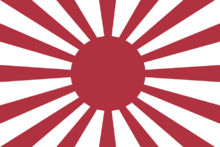
- Draw a ball
- Fill in with white
- Draw a red circle in the middle
- Add sixteen red beams radiating from the circle
- Draw slanted eyes
- (Optional) Draw a "Kanmuri", a Japanese hat worn by Japanese Emperors throughout history.
| Color Name | HEX | RGB | |
|---|---|---|---|
| White | #FFFFFF | 255, 255, 255 | |
| Red | #B22D3D | 178, 45, 61 | |
Relationships
大東亜共栄圏 (Co-Prosperity Sphere)
 帝国主義 - My father who taught me everything. Western imperialism is evil, Japanese imperialism is good!
帝国主義 - My father who taught me everything. Western imperialism is evil, Japanese imperialism is good! 国家神道 - Worship me!
国家神道 - Worship me! 民族社会主義(ナチズム) - This whole axis thing sounds cool.
民族社会主義(ナチズム) - This whole axis thing sounds cool. 死の崇拝 - 皇帝のために死ぬことは永遠に生きることですよ!(TO DIE FOR THE EMPEROR IS TO LIVE FOREVER!!!)
死の崇拝 - 皇帝のために死ぬことは永遠に生きることですよ!(TO DIE FOR THE EMPEROR IS TO LIVE FOREVER!!!) ファシズム - You guys fight for your glorious nation and hate America. 凄いね! (Sugoi!)
ファシズム - You guys fight for your glorious nation and hate America. 凄いね! (Sugoi!) ウルトラナショナリズ - GLORY TO JAPAN!
ウルトラナショナリズ - GLORY TO JAPAN! 半立憲君主制 - The Emperor, our great leader.
半立憲君主制 - The Emperor, our great leader. 軍閥政治 - Our great military shall conquer all of Asia!!!
軍閥政治 - Our great military shall conquer all of Asia!!! コーポラトクラシー - Zaibatsu go brrr.
コーポラトクラシー - Zaibatsu go brrr. アジア主義 - ASIA FOR ASIANS! We must liberate all of Asia from Western imperialism
アジア主義 - ASIA FOR ASIANS! We must liberate all of Asia from Western imperialism and put them under new management of course. オルタナ右翼 / ネット右翼 - Thanks for defending me online!
オルタナ右翼 / ネット右翼 - Thanks for defending me online! インセル
インセル  - Same as above, plus the "right to sex" thing sounds attractive...
- Same as above, plus the "right to sex" thing sounds attractive... ヒンドゥトヴァ - Thanks for speaking out in defense of our guys, Radhabinod Pal.
ヒンドゥトヴァ - Thanks for speaking out in defense of our guys, Radhabinod Pal.
フレネミー (Frenemies)
 無政府君主制主義 - How does this show honor?! Go commit seppuku!
無政府君主制主義 - How does this show honor?! Go commit seppuku! マルクス・レーニン主義 (Pre-1945) - Soviet trash, get ready to be pwned! (Although, thank you for the neutrality pact![7])
マルクス・レーニン主義 (Pre-1945) - Soviet trash, get ready to be pwned! (Although, thank you for the neutrality pact![7]) シオニズム - I'm a great ally to
シオニズム - I'm a great ally to  him but my Fugu plan will keep you safe.
him but my Fugu plan will keep you safe. シルバーレジオニズム - You have the right idea, but you're a filthy American!
シルバーレジオニズム - You have the right idea, but you're a filthy American! 日本自民党 - Well it could be far worse...
日本自民党 - Well it could be far worse... 第四の理論 - I do the same thing, but with East Asians. Though Russian dominance is cringe
第四の理論 - I do the same thing, but with East Asians. Though Russian dominance is cringe 三民主義
三民主義  - Based Pan-Asianism but cringe for embracing Western values and for declaring war on me during WWII. However, Wang Jingwei is mega-based for allying with me and Chiang Kai-shek considered me a lesser evil to the commies and pardoned many of my followers such as Yasuji Okamura and Masanbu Tsuji during the Cold War.
- Based Pan-Asianism but cringe for embracing Western values and for declaring war on me during WWII. However, Wang Jingwei is mega-based for allying with me and Chiang Kai-shek considered me a lesser evil to the commies and pardoned many of my followers such as Yasuji Okamura and Masanbu Tsuji during the Cold War. 一民主義 - Same as above. Claim to hate me but Syngman Rhee spared many Chinilpa, including Park Chung-hee himself, and cooperated with successors against the commies during the Cold War.
一民主義 - Same as above. Claim to hate me but Syngman Rhee spared many Chinilpa, including Park Chung-hee himself, and cooperated with successors against the commies during the Cold War.
西洋帝国主義のスカム!!! (WESTERN IMPERIALIST SCUM!!!)
 部族主義 - Ainu and Ryukyuan scum.
部族主義 - Ainu and Ryukyuan scum. 犬-
犬- MARUTAAAAAAchinese scum 毛沢東思想 - Communist + Chinese = DOUBLE CRINGE!
毛沢東思想 - Communist + Chinese = DOUBLE CRINGE! 新保守主義 - American scum.
新保守主義 - American scum. ニューディール主義
ニューディール主義  - YOU KILLED JAPANESE PEOPLE AND NUKED ME! TWICE!
- YOU KILLED JAPANESE PEOPLE AND NUKED ME! TWICE! 反日亡国論 - Self-hating Japanese who want to stop my imperialism against the world!
反日亡国論 - Self-hating Japanese who want to stop my imperialism against the world! 主体思想 - Colonial rabble.
主体思想 - Colonial rabble. 日本のマルクス主義 - You are a threat to the Emperor! You shall be banned!
日本のマルクス主義 - You are a threat to the Emperor! You shall be banned! リベラル・フェミマンコ - Rape culture? Based
リベラル・フェミマンコ - Rape culture? Based even though we never did that. 無政府共産主義 - REEEEEEEE GET OUT OF MANCHURIA!
無政府共産主義 - REEEEEEEE GET OUT OF MANCHURIA! マルクス・レーニン主義 (post-1945) - REEEEE, I KNOW I AM LOSING, BUT YOU CAN’T JUST BREAK OUR PEACE AGREEMENT!!!!!!
マルクス・レーニン主義 (post-1945) - REEEEE, I KNOW I AM LOSING, BUT YOU CAN’T JUST BREAK OUR PEACE AGREEMENT!!!!!!
Further Information
Wikipedia
- Showa Statism
- Showa
- Empire of Japan
- Greater East Asia Co-Prosperity Sphere
- Showa nationalist propaganda
- List of Japanese political figures in the Showa period
- Nippon Kaigi
- Netto-uyoku
- Japanese war crimes
- Comfort women
- Second Sino-Japanese War
Videos
- Imperial Japan: The Fall of Democracy by
 Kraut
Kraut - Playing the Victim | Historical Revisionism and Japan by
 Knowing Better
Knowing Better
Gallery
Comics
Portraits and Artwork
Alternative designs
-
The Righteous Army (Kōdōha)
-
Toseiha
References
- ↑ [1], JSTOR.org.
- ↑ Refers to Showaists and foreign sympathizers with socialist views and genuinely motivated by Pan-Asianism and opposition to Western imperialism
- ↑ Refers to Japanese Showaists and foreign collaborators that were inspired by European colonialism and collaborated with the US and Chiang Kai-shek's KMT during the Cold War e.g. Nobusuke Kishi, Masanobu Tsuji, Yoshio Kodama, Matsutarō Shōriki, Yasuji Okamura, Ryochi Sasakawa, etc.
- ↑ [2]
- ↑ [3]
- ↑ [4]
- ↑ https://en.wikipedia.org/wiki/Soviet%E2%80%93Japanese_Neutrality_Pact
| | |
| | |
| Main Related Self-Inserts | |
| Main Definitions Application Related Other Ideologies Self-Inserts | |
Self-Inserts | |
| | |
| | |
| Main Related Self-Inserts | |
| Main Definitions Application Related Other Ideologies Self-Inserts | |
Self-Inserts | |
